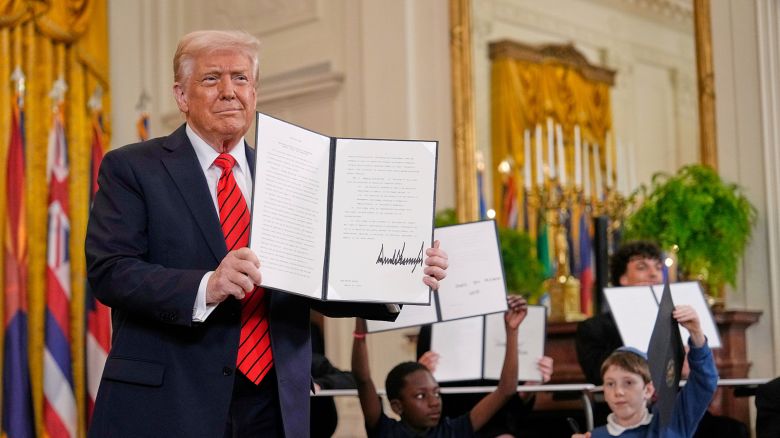
On March 20, 2025, President Donald Trump signed an executive order directing Education Secretary Linda McMahon to “take all necessary steps to facilitate the closure” of the U.S. Department of Education (DoE), marking a bold step toward fulfilling a long-standing campaign promise. While the complete abolition of this cabinet-level agency requires congressional approval—a hurdle Trump acknowledges—the administration has already slashed nearly half its workforce and begun unraveling its operations. As of March 22, 2025, this move has ignited fierce debate over its implications for America’s students, educators, and the broader education system. What does this mean for the United States? Let’s unpack the seismic impacts—both immediate and long-term.
The Executive Order: A Blueprint for Change
The order, titled “Improving Education Outcomes by Empowering Parents, States, and Communities,” frames the DoE as a failed experiment in federal overreach. Citing stagnant test scores despite trillions in spending since its 1979 inception, Trump argues that returning education to state and local control will better serve students. The White House has already cut roughly 2,000 of the department’s 4,400 employees, with plans to redistribute key functions—like student loans and civil rights enforcement—to other agencies or states. While Trump insists programs like Title I (for low-income schools) and IDEA (for students with disabilities) will be “preserved,” the details remain murky, leaving educators, parents, and lawmakers scrambling to predict the fallout.
Immediate Impacts: Chaos and Uncertainty
The most pressing effect is disruption. With half the DoE’s staff gone—600 resigned voluntarily, others placed on leave or laid off—the agency’s capacity to manage its $238 billion 2024 budget is crippled. Programs like Pell Grants, which aided over 6 million low-income college students last year, and the $1.6 trillion federal student loan portfolio face administrative upheaval. Trump has suggested shifting loans to the Treasury or Commerce Departments, but no clear transition plan exists yet. Borrowers, already reeling from reversed Biden-era debt relief, could see delays, higher interest rates, or privatization pressures, as some X posts speculate.
K-12 schools, where federal funds make up about 10% of budgets, are also on edge. Title I ($18.4 billion) and IDEA ($15.5 billion) support high-poverty districts and 7.5 million students with disabilities, respectively. Without a functioning DoE, states may struggle to distribute these funds efficiently, especially in rural, red states like Mississippi and Alabama, which rely heavily on them. “You can’t just move dollars like that without downstream impacts,” warned education policy expert Joshua Cowen in an NBC interview. Teachers fear larger class sizes, job cuts, or even school closures if gaps aren’t filled—a sentiment echoed by Governor Tony Evers on X.
Civil Rights Enforcement in Jeopardy
The DoE’s Office for Civil Rights (OCR), tasked with enforcing laws against discrimination based on race, gender, disability, and more, is another casualty. Reports suggest seven of its 12 regional offices have lost all staff, gutting its ability to investigate complaints—over 10,000 annually in recent years. Critics, including the ACLU, warn this could leave students vulnerable to unchecked bias, from transgender bathroom bans to racial disparities in discipline. Trump’s team counters that states or the Justice Department could take over, but skeptics doubt cash-strapped states or an already-stretched DOJ can match the OCR’s scope.
Long-Term Implications: A Fragmented System
If Trump’s vision succeeds—either through congressional action or sustained executive pressure—the U.S. could see a patchwork education landscape. States would gain near-total control over curricula, standards, and funding, amplifying existing disparities. Wealthy states like New York might thrive, while poorer ones like New Mexico could falter without federal backstops. “States aren’t prepared,” said Connecticut lawmaker Maryam Khan to NBC, highlighting the lack of infrastructure to absorb DoE duties overnight.
Higher education faces its own reckoning. Beyond loans, the DoE oversees FAFSA, work-study, and accreditation—linchpins for 19 million college students. Shifting these to other agencies risks inefficiencies, while Trump’s push to cut “woke” funding (e.g., $175 million from UPenn over transgender sports) signals a cultural clampdown. Universities are bracing for freezes and reviews, with Duke already slashing staff budgets preemptively.
Winners and Losers
Proponents, including some X users like
@flyofsolar, cheer the return of local control, arguing it lets communities tailor education to their values—less “liberal indoctrination,” more flexibility. School choice advocates see a boon, with Trump eyeing vouchers to redirect public funds to private schools. Rural GOP-led states might welcome block grants over restrictive federal rules.
But the losers could be legion. Low-income students, rural districts, and those with disabilities—historically reliant on DoE protections—face the steepest risks. Teachers unions, like the NEA, warn of “catastrophic” cuts to jobs and equity programs. Democrats, led by figures like Chuck Schumer, decry it as an attack on vulnerable kids, with 63% of Americans opposing closure in a recent NPR/PBS poll.
The Road Ahead
Trump can’t shutter the DoE alone—Congress holds the keys, and with a 53-47 GOP Senate majority, he’d need Democratic votes he’s unlikely to win. Legal challenges loom, too; the Impoundment Control Act could block him from withholding appropriated funds. Yet his aggressive staff cuts and reorganization signal a de facto dismantling, daring opponents to stop him. “He knows he can’t abolish it outright, but he can smash it to pieces,” Senator Patty Murray told Reuters.
The impacts hinge on execution. If states rise to the challenge, education could become more localized and innovative. If they falter, the U.S. risks widening gaps in opportunity and achievement. As steel dust settles from this wrecking ball, one thing’s clear: America’s education system is in uncharted territory, and the stakes—for 50 million public school kids and beyond—couldn’t be higher.
What do you think? Is this a bold fix for a broken system, or a reckless gamble with kids’ futures? Let me know below!






